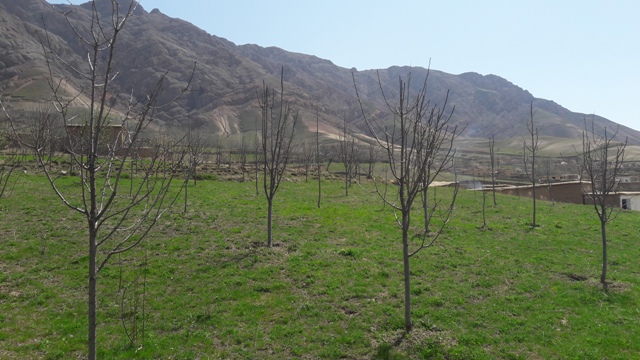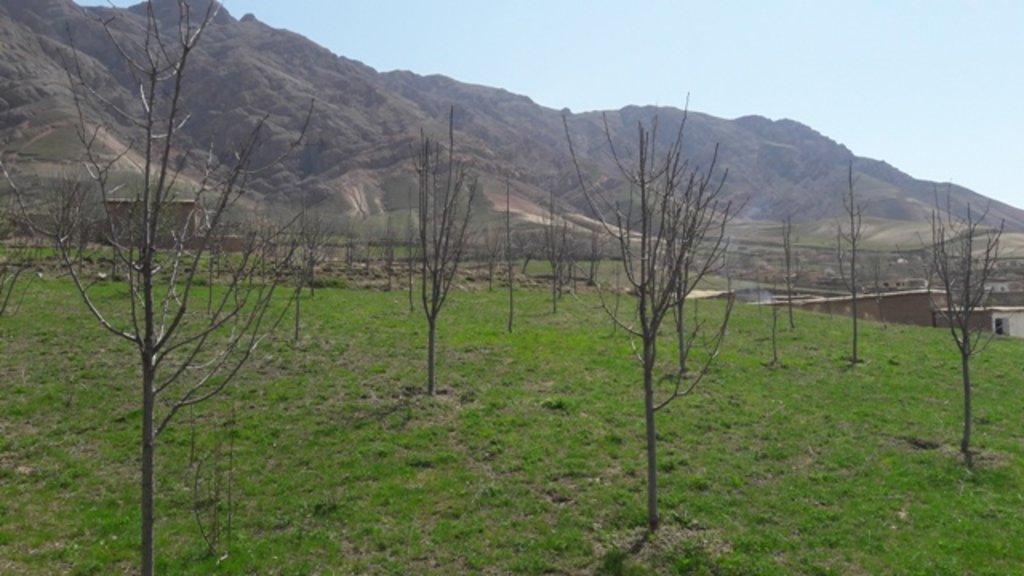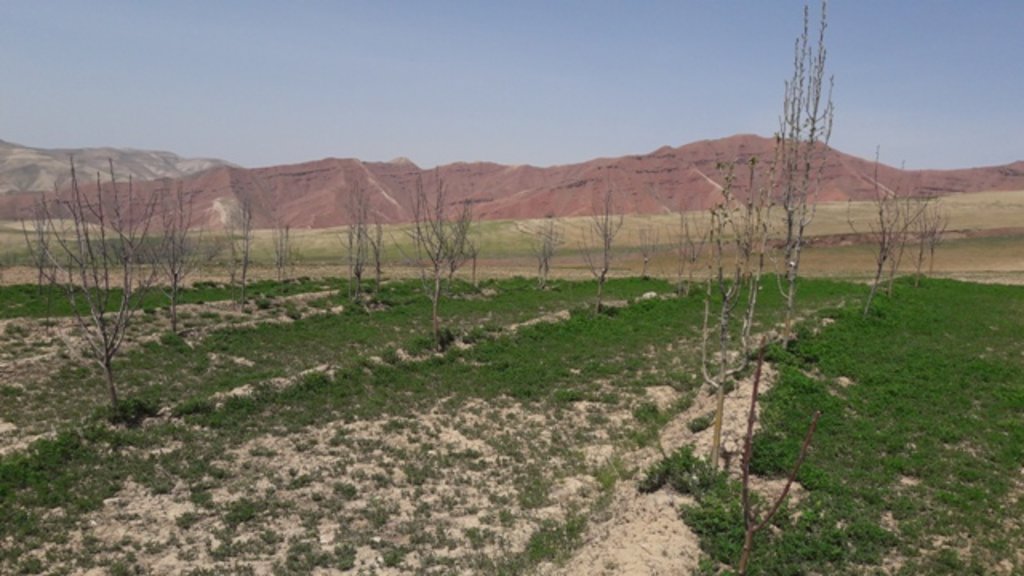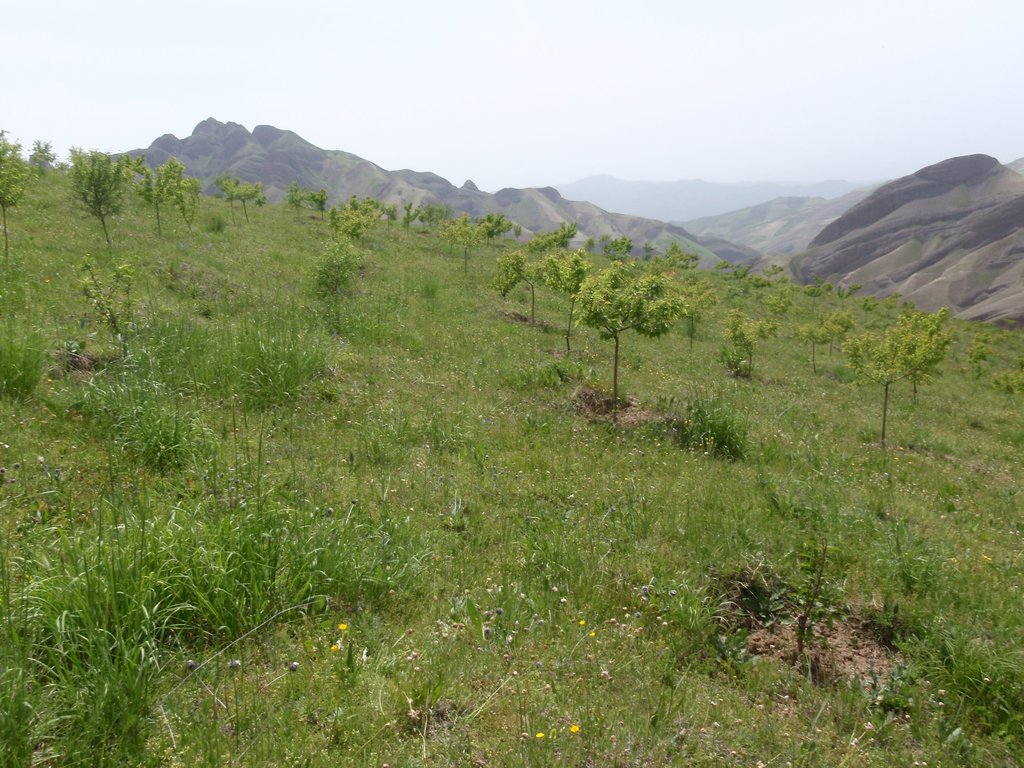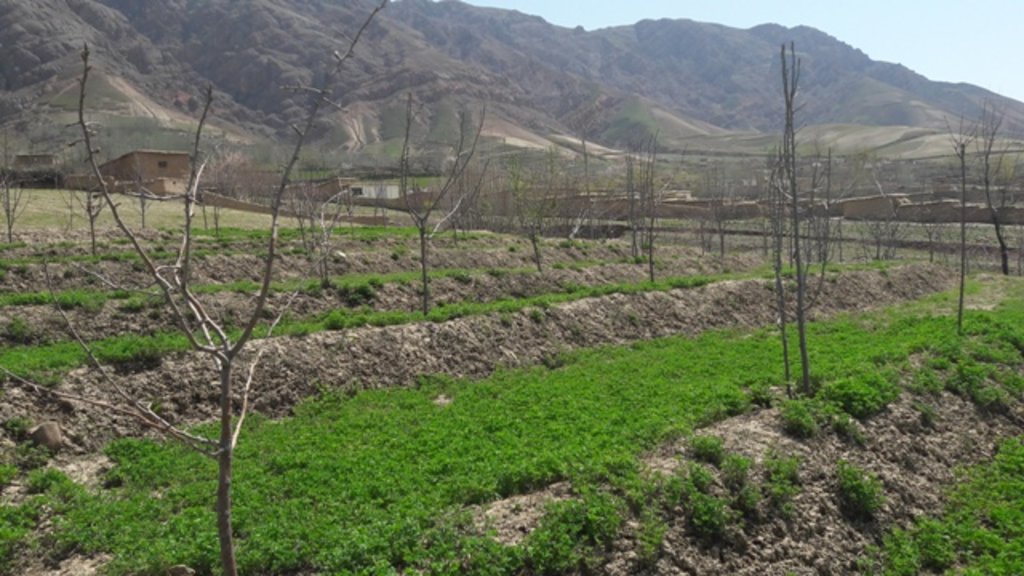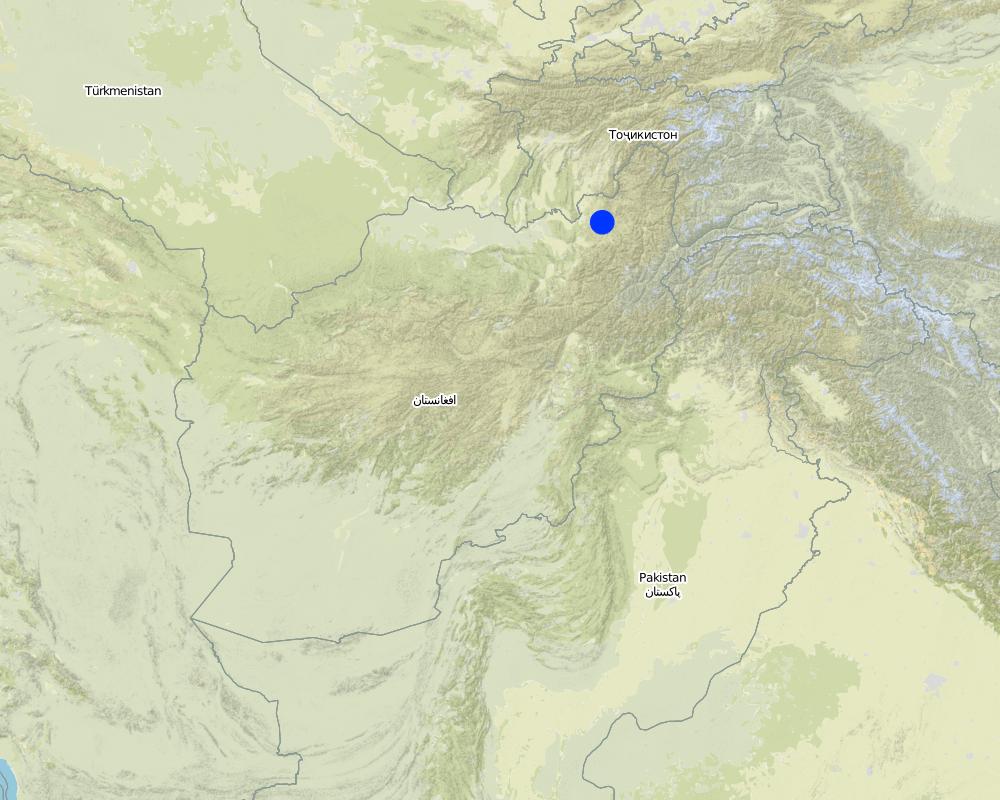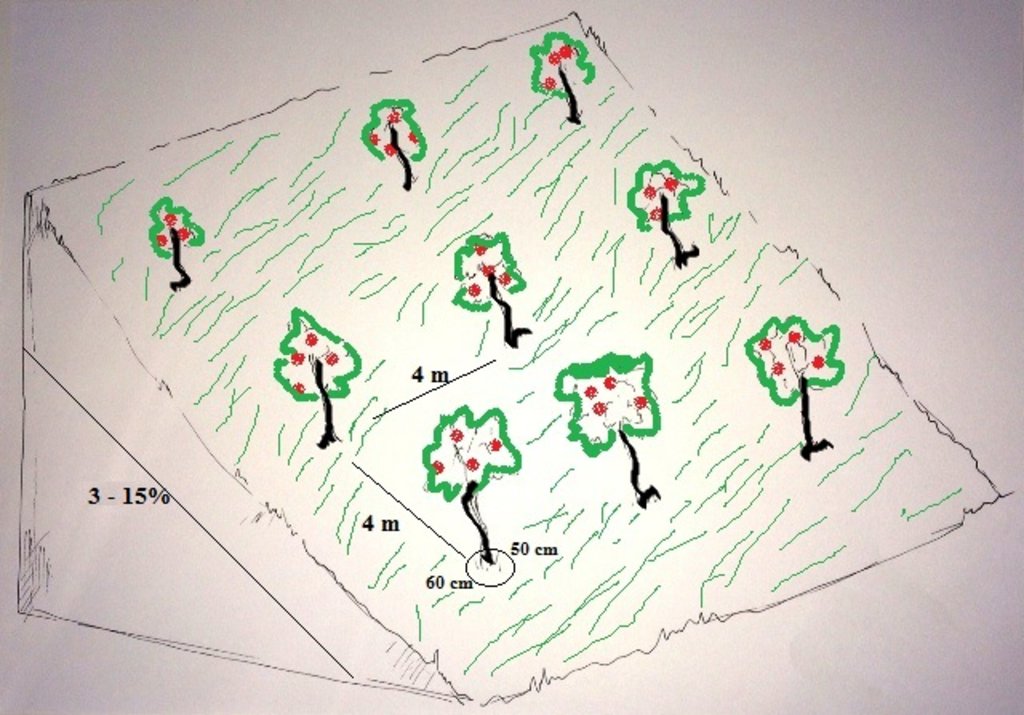Establishment of improved orchards and vineyards [Afganistán]
- Creación:
- Actualización:
- Compilador: Bettina Wolfgramm
- Editor: Roziya Kirgizbekova
- Revisor: Rima Mekdaschi Studer
Bunyodi boghi va boghi anguri behbudyofta
technologies_669 - Afganistán
Visualizar secciones
Expandir todo Colapsar todos1. Información general
1.2 Detalles de contacto de las personas de referencia e instituciones involucradas en la evaluación y la documentación de la Tecnología
Persona(s) de referencia clave
usuario de la tierra:
Mirza Bay Gholam Sakhi
Natural Resources Management Comittee (NRMC)
Sari Joy Village, Rustaq District
Afganistán
Especialista MST:
Especialista MST:
Researcher:
Nombre del proyecto que financió la documentación/ evaluación de la Tecnología (si fuera relevante)
Livelihood Improvement Project Takhar, Afghanistan (LIPT)Nombre del proyecto que financió la documentación/ evaluación de la Tecnología (si fuera relevante)
Potential and limitations for improved natural resource management (NRM) in mountain communities in the Rustaq district, Afghanistan (Rustaq NRM Study)Nombre de la(s) institución(es) que facilitaron la documentación/ evaluación de la Tecnología (si fuera relevante)
Terre des Hommes (Terre des Hommes) - SuizaNombre de la(s) institución(es) que facilitaron la documentación/ evaluación de la Tecnología (si fuera relevante)
Swiss Agency for Development and Cooperation (DEZA / COSUDE / DDC / SDC) - SuizaNombre de la(s) institución(es) que facilitaron la documentación/ evaluación de la Tecnología (si fuera relevante)
Bern University of Applied Sciences, School of Agricultural, Forest and Food Sciences (HAFL) - SuizaNombre de la(s) institución(es) que facilitaron la documentación/ evaluación de la Tecnología (si fuera relevante)
CDE Centre for Development and Environment (CDE Centre for Development and Environment) - Suiza1.3 Condiciones referidas al uso de datos documentados mediante WOCAT
¿Cuándo se compilaron los datos (en el campo)?
27/10/2016
El compilador y la/s persona(s) de referencia claves aceptan las condiciones acerca del uso de los datos documentados mediante WOCAT:
Sí
1.4 Declaración de la sostenibilidad de la Tecnología descrita
¿La Tecnología aquí descrita resulta problemática en relación a la degradación de la tierra, de tal forma que no puede considerársela una tecnología sostenible para el manejo de la tierra?
No
Comentarios:
SLM practices documented in the frame of the Rustaq NRM study were established only recently (1-3 years ago). It is too early for a final judgment on the sustainability of these technologies within the human and natural environment of Chokar watershed.
2. Descripción de la Tecnología MST
2.1 Breve descripción de la Tecnología
Definición de la Tecnología:
Local and new varieties of fruits are planted on degraded land in accordance with improved management practices. The established orchards and vineyards serve double purpose of soil protection and income generation for the rural households. The alfalfa under the trees supports tree growth and is used for livestock fodder.
2.2 Descripción detallada de la Tecnología
Descripción:
Project supported implementation of improved orchards and vineyards has taken place in the villages Sari Joy, Jawaz Khana and Dashti Mirzai, located in Chokar watershed of Rustaq District in Northern Afghanistan. The Chokar watershed is a mountainous area situated between 600 - 2,500 m above sea level. The climate is semi-arid with harsh and cold weather in winter and hot and dry summers. The annual precipitation in average years is 580mm. Land degradation affects all forms of land use and includes low vegetation cover, heavy top soil erosion from water, and poor soil fertility. Unsustainable agricultural practices, over-exploitation and high pressure on the natural resources are adversely impacting on the socio-economic well-being of local communities as well as contributing to the risk for being adversely affected by drought as well as landslides and flash foods triggered by heavy rainfall. The data used for the documentation of the technology is based on field research conducted in Chokar watershed, namely in the villages: Sari Joy, Jawaz Khana and Dashti Mirzai. These villages represent the upper, the middle and the lower zone of Chokar watershed, respectively. They differ considerably in access to services and infrastructure, but in general are poorly served. The communities depend on land resources for sustaining their livelihoods. In a good year with high yields, wheat-self-sufficiency lasts about 5 months. The three villages are home to ethnic Qarluq communities. Since 2012 the Livelihood Improvement Project Takhar (LIPT) implemented by Terre des hommes (Tdh) Switzerland has initiated a range of NRM interventions.
The rural population in Rustaq district of Afghanistan traditionally grows local varieties of apples, pears and grapes. Mostly it is subsistence farming with a small-scale local marketing. Shortage of irrigation water and lack of specific knowledge about horticultural and viticulture practices, negatively affects fruit yields. Apart of providing diverse fruits for consumption, orchards are also important for providing fodder for the livestock, retaining soil moisture and protecting the soil from erosion.
The local land users interested in the establishment of improved orchards and vineyards were mobilized through the Natural Resources Management Committees (NRMC) in Sari Joy, Jawaz Khana and Dashti Mirzai villages. In addition to the local varieties of pears, apples and grapes, new improved varieties were used for orchards and vineyards on 6.5 ha of degraded land. Such orchards were established inside or close to the villages on mountain slopes with gentle (3-5%) and moderate (6 -15%) steepness. Fruit trees are planted on locally identified dark and light soils, which correspond to moderately deep and loamy soil of medium soil fertility. Considering the medium quality of the soil, the first step of tree plantation is application of organic fertilizer. Afterwards, the plot is designed according to 4m x 4 m spacing between the trees. Under such parameters, on 1 jirib (0.2 ha) of land 125 fruit tree (apple or pear) seedlings are planted. The depth of the planting pits is 60 x 50 cm. The planted tree is watered and the lower trunk is covered with lime and water solution. Alfalfa is sown under the trees to serve as a fodder for the livestock. The orchards are irrigated mostly during summer once a week. In areas where there is shortage of irrigation water the trees are rainfed. Other maintenance activities include pest and disease control provided by a trained local specialist.
The new orchards only recently started giving fruits. The actual fruit yields are expected in 2017-2018. Expected higher yields of improved verities of pears, apples and grapes serves as a strong incentive for the local land users and their families to establish and maintain the orchards. Orchards are very demanding, but their reward is very promising in terms of improved harvest and more opportunities to sell the produce. Some land users have successful experience on their plots and already have fruits in their gardens and plan to enlarge their garden and plant more varieties of fruit trees, such as persimmons. Alfalfa which grows under the trees has important production value, particularly during the early years after the establishment phase, when the trees are too young to give fruits.
Female members of the households, which implemented orchards are also involved in establishing and maintaining orchards and vineyards. They take part in planting trees, watering, hay making and protecting the trees from livestock and people. Their contribution, plays an important part for the successful implementation of improved orchards and vineyards in Sari Joy, Jawaz Khana and Dashti Mirzai.
2.3 Fotografías de la Tecnología
2.5 País/ región/ lugares donde la Tecnología fue aplicada y que se hallan comprendidos por esta evaluación
País:
Afganistán
Región/ Estado/ Provincia:
Takhar Province, Rustaq District
Especifique más el lugar :
Sari Joy, Jawaz Khana, Dashti Mirzai
Comentarios:
This documentation is based on the experiences of SLM implementers from Sari Joy (8 plots), Jawaz Khana, (6 plots), and Dashti Mirzai (3 plots). Additionally insights were gained through interviews with both SLM implementers and observers from all three villages.
Map
×2.6 Fecha de la implementación
Si no se conoce el año preciso, indique la fecha aproximada:
- hace menos de 10 años (recientemente)
2.7 Introducción de la Tecnología
Especifique cómo se introdujo la Tecnología:
- mediante proyectos/ intervenciones externas
Comentarios (tipo de proyecto, etc.):
Livelihood Improvement Project Takhar (LIPT) supported by Swiss Development Cooperation (SDC) from 2012-17
3. Clasificación de la Tecnología MST
3.1 Propósito(s) principal(es) de la Tecnología MST
- mejorar la producción
3.2 Tipo(s) actuales de uso de la tierra donde se aplica la Tecnología

Tierras cultivadas
- Cultivos perennes (no leñosos)
- Cosecha de árboles y arbustos

Cultivos asociados (cultivos/ pastoreo/ árboles), incl. agroforestería
- Agropastoreo
Principales productos/ servicios:
Apple, pear, almond, grapes, alfalfa
Si el uso de la tierra ha cambiado debido a la implementación de la Tecnología, indique el uso de la tierra antes de la implementación de la Tecnología.
About half of orchard plots are established on cropland.
3.3 Información adicional sobre el uso de tierras
Provisión de agua para la tierra donde se aplica la Tecnología:
- mixta de secano – irrigada
Comentarios:
Often the trees are watered with supplementary irrigation, from irrigation channels, or fetching the water in buckets.
Número de temporadas de cultivo por año:
- 1
3.4 Grupo MST al que pertenece la Tecnología
- agroforestería
3.5 Difusión de la Tecnología
Especifique la difusión de la Tecnología:
- distribuida parejamente sobre un área
Si la tecnología se halla difundida homogéneamente en un área, indique el área aproximada que cubre:
- < 0.1 km2 (10 ha)
3.6 Medidas MST que componen la Tecnología

medidas vegetativas
- V1: Cubierta de árboles y arbustos
- V2: Pastos y plantas herbáceas perennes

medidas de manejo
- M1: Cambio de tipo de uso de la tierra
Comentarios:
Many land users establish a fence around their orchards to protect the trees from animal and the fruits from theft.
3.7 Principales tipos de degradación de la tierra encarados con la Tecnología

erosión de suelos por agua
- Wt: pérdida de capa arable/ erosión de la superficie

erosión de suelos por viento
- Et: pérdida de capa arable

degradación biológica
- Bc: reducción de la cobertura vegetal del suelo
- Bq: reducción de la cantidad/ biomasa

degradación del agua
- Ha: aridificación
3.8 Prevención, reducción o restauración de la degradación de la tierra
Especifique la meta de la Tecnología con relación a la degradación de la tierra:
- prevenir la degradación de la tierra
- reducir la degradación de la tierra
4. Especificaciones técnicas, actividades de implementación, insumos y costos
4.1 Dibujo técnico de la Tecnología
4.2 Especificaciones técnicas/ explicaciones del dibujo técnico
Orchards are established on mountain slopes with gentle (3-5%) and moderate (6-10%) steepness. Considering the medium soil fertility, the first step of tree plantation is application of organic fertilizer. Afterwards, the plot is designed according to 4m x 4 m spacing between rows and trees. Under such parameters, on 1 jirib (0.2 ha) of land 125 fruit tree (apple or pear) seedlings are planted. The depth of the planting pits is 60 x 50 cm. The planted tree is watered and the lower trunk is covered with lime and water solution. Alfalfa is sown under the trees for livestock fodder.
4.3 Información general sobre el cálculo de insumos y costos
Especifique cómo se calcularon los costos e insumos:
- por área de Tecnología
Indique tamaño y unidad de área:
1 ha
Especifique la moneda usada para calcular costos:
- dólares americanos
Indique la tasa de cambio de USD a la moneda local (si fuese relevante): 1 USD =:
67,0
Indique el costo promedio del salario de trabajo contratado por día:
5.2-5.3 USD per day
4.4 Actividades de establecimiento
| Actividad | Tipo de medida | Momento | |
|---|---|---|---|
| 1. | Selection of the area for orchard (Men) | Manejo | Fall |
| 2. | Applicatoin of manure (Men) | Agronómicas | Fall/Winter |
| 3. | Design of tree spacing in the orchard assisted by project staff (Men) | Manejo | End of winter |
| 4. | Digging pits for planting (Men/Women) | Estructurales | Spring |
| 5. | Planting of fruit trees (Men/Women) | Agronómicas | Spring |
| 6. | Sowing of alfalfa under the trees (Men/Women) | Vegetativas | Spring |
4.5 Costos e insumos necesarios para el establecimiento
| Especifique insumo | Unidad | Cantidad | Costos por unidad | Costos totales por insumo | % de los costos cubiertos por los usuarios de las tierras | |
|---|---|---|---|---|---|---|
| Mano de obra | Application of manure | person-day | 5,0 | 5,3 | 26,5 | 83,0 |
| Mano de obra | Design of tree spacing | person-day | 5,0 | 5,3 | 26,5 | |
| Mano de obra | Digging pits for planting | person-day | 15,0 | 5,3 | 79,5 | 83,0 |
| Mano de obra | Planting trees, sowing alfalfa and watering | person-day | 10,0 | 5,3 | 53,0 | 83,0 |
| Equipo | Meter | piece | 1,0 | 2,25 | 2,25 | |
| Equipo | Rope | Meter | 500,0 | 0,07 | 35,0 | |
| Equipo | Shovel | piece | 2,0 | 3,8 | 7,6 | |
| Equipo | Pick axe | piece | 1,0 | 2,25 | 2,25 | |
| Material para plantas | Seedlings (apple/pear) | piece | 625,0 | 0,75 | 468,75 | |
| Material para plantas | Alfalfa seeds | kg | 17,5 | 0,42 | 7,35 | |
| Fertilizantes y biocidas | DAP | Kg | 250,0 | 0,9 | 225,0 | |
| Fertilizantes y biocidas | Urea | Kg | 250,0 | 0,45 | 112,5 | |
| Fertilizantes y biocidas | Animal manure | ton | 10,0 | 60,0 | 600,0 | |
| Fertilizantes y biocidas | Pesticide | cc | 500,0 | 0,9 | 450,0 | |
| Fertilizantes y biocidas | Lime | Kg | 25,0 | 1,5 | 37,5 | |
| Costos totales para establecer la Tecnología | 2133,7 | |||||
Si el usuario de la tierra no cubrió el 100% de los costos, indique quién financió el resto del costo:
Livelihood Improvement Project Takhar (LIPT) implemented by Terre des hommes (Tdh) Switzerland
Comentarios:
Costs calculated for a Technology area of 1ha was only done for the purpose of the WOCAT documentation. In reality SLM plots are on average 0.2- 0.4 ha or 1- 2 jiribs. Costs were simply multiplied by 5. The actual costs for a 1ha plot might be slightly different.
4.6 Actividades de establecimiento/ recurrentes
| Actividad | Tipo de medida | Momento/ frequencia | |
|---|---|---|---|
| 1. | Watering of the trees (Men/Women) | Agronómicas | 2 times/month/Summer |
| 2. | Weeding (Women) | Agronómicas | |
| 3. | Pruning (Men) | Agronómicas | |
| 4. | Lime application (Men) | Agronómicas | |
| 5. | Hay making (Men/Women) | Agronómicas | |
| 6. | Harvesting fruits (Men/Women) | Agronómicas |
4.7 Costos e insumos necesarios para actividades de mantenimiento/ recurrentes (por año)
| Especifique insumo | Unidad | Cantidad | Costos por unidad | Costos totales por insumo | % de los costos cubiertos por los usuarios de las tierras | |
|---|---|---|---|---|---|---|
| Mano de obra | Irrigation | person day | 5,0 | 5,3 | 26,5 | 100,0 |
| Mano de obra | Weeding | person day | 5,0 | 5,3 | 26,5 | 100,0 |
| Mano de obra | Pruning | person day | 5,0 | 5,3 | 26,5 | 100,0 |
| Mano de obra | Lime application | person day | 5,0 | 5,3 | 26,5 | 100,0 |
| Equipo | Scissors for pruning | piece | 2,0 | 9,0 | 18,0 | |
| Fertilizantes y biocidas | Lime | Kg | 25,0 | 1,5 | 37,5 | 100,0 |
| Indique los costos totales para mantenecer la Tecnología | 161,5 | |||||
Si el usuario de la tierra no cubrió el 100% de los costos, indique quién financió el resto del costo:
Livelihood Improvement Project Takhar (LIPT) implemented by Terre des Hommes (Tdh) Switzerland
Comentarios:
Costs calculated for a Technology area of 1ha was only done for the purpose of the WOCAT documentation. In reality SLM plots are on average 0.2- 0.4 ha or 1- 2 jiribs. Costs were simply multiplied by 5. The actual costs for a 1ha plot might be slightly different.
4.8 Factores más determinantes que afectan los costos:
Describa los factores más determinantes que afectan los costos:
Due to the remoteness of the villages where the Technology has been implemented, all the inputs for establishment, such as agricultural equipment, plant material, fertilizers, etc., are purchased in Rustaq town. The expenses for traveling and delivering the inputs affect the establishment costs.
5. Entorno natural y humano
5.1 Clima
Lluvia anual
- < 250 mm
- 251-500 mm
- 501-750 mm
- 751-1,000 mm
- 1,001-1,500 mm
- 1,501-2,000 mm
- 2,001-3,000 mm
- 3,001-4,000 mm
- > 4,000 mm
Especifique el promedio anual de lluvia (si lo conoce), en mm:
580,00
Especificaciones/ comentarios sobre la cantidad de lluvia:
Average annual percipitation for the area was calculated with 580 mm, with minimums in dry years (2000 and 2001) of 270 mm and maximums in wet years (2009/2010) of 830 mm. The absolut maximum rainfall was calculated for 1986 with 1024 mm. The data series covers the time from 1979 to 2014.
Indique el nombre de la estación metereológica de referencia considerada:
Climate Forecast System Reanalysis (CFSR), http://rda.ucar.edu/pub/cfsr.html
Zona agroclimática
- semi-árida
Derived from the publicly available dataset on length of growing period (LGP) (Fischer 2009 / IIASA-FAO). Internet link: http://tiles.arcgis.com/tiles/P8Cok4qAP1sTVE59/arcgis/rest/services/Length_of_growing_period/MapServer
5.2 Topografía
Pendientes en promedio:
- plana (0-2 %)
- ligera (3-5%)
- moderada (6-10%)
- ondulada (11-15%)
- accidentada (16-30%)
- empinada (31-60%)
- muy empinada (>60%)
Formaciones telúricas:
- meseta/ planicies
- cordilleras
- laderas montañosas
- laderas de cerro
- pies de monte
- fondo del valle
Zona altitudinal:
- 0-100 m s.n.m.
- 101-500 m s.n.m.
- 501-1,000 m s.n.m
- 1,001-1,500 m s.n.m
- 1,501-2,000 m s.n.m
- 2,001-2,500 m s.n.m
- 2,501-3,000 m s.n.m
- 3,001-4,000 m s.n.m
- > 4,000 m s.n.m
5.3 Suelos
Profundidad promedio del suelo:
- muy superficial (0-20 cm)
- superficial (21-50 cm)
- moderadamente profunda (51-80 cm)
- profunda (81-120 cm)
- muy profunda (>120 cm)
Textura del suelo (capa arable):
- mediana (limosa)
Textura del suelo (> 20 cm debajo de la superficie):
- mediana (limosa)
Materia orgánica de capa arable:
- media (1-3%)
- baja (<1%)
Si se halla disponible, adjunte una descripción completa de los suelos o especifique la información disponible, por ej., tipo de suelo, pH/ acidez de suelo, capacidad de intercambio catiónico, nitrógeno, salinidad, etc. :
Local land users differentiate between the following soil types where orchards and vineyards are established:
- Light soil: moderately deep; texture medium; medium, low organic matter
- Dark soil: moderately deep; texture medium, medium; medium organic matter
5.4 Disponibilidad y calidad de agua
Agua subterránea:
5-50 m
Disponibilidad de aguas superficiales:
mediana
Calidad de agua (sin tratar):
agua potable de buena calidad
¿La salinidad del agua es un problema?
No
¿Se está llevando a cabo la inundación del área? :
Sí
Frecuencia:
frecuentemente
Comentarios y especificaciones adicionales sobre calidad y cantidad de agua:
Floods occur mainly during the rainy seasons in spring and autumn. Availability of surface water differs for the three study villages Sari Joy, Jawaz Khana, and Dashti Mirzai. Sari Joy has sources and good surface water availability. Jawaz Khana has poor water availability as water has to be fetched from a lower laying stream. Dashti Mirzai has good water availability also from an irrigation channel.
5.5 Biodiversidad
Diversidad de especies:
- baja
Diversidad de hábitats:
- baja
5.6 Las características de los usuarios de la tierra que aplican la Tecnología
Sedentario o nómada:
- Sedentario
Orientación del mercado del sistema de producción:
- subsistencia (autoprovisionamiento)
- mixta (subsistencia/ comercial)
Ingresos no agrarios:
- 10-50% de todo el ingreso
- > 50% de todo el ingreso
Nivel relativo de riqueza:
- promedio
- rico
Individuos o grupos:
- individual/ doméstico
Nivel de mecanización:
- trabajo manual
Género:
- mujeres
- hombres
Edad de los usuarios de la tierra:
- personas de mediana edad
- ancianos
Indique otras características relevantes de los usuarios de las tierras:
The land users in the area where the Technology is applied belong to the Uzbek ethnic minority group Qarluq.
Although the men are generally the main land users, however, women and children also take active part in the related work. The functions of men and women are clearly distinguished within the Afghan society. At the same time within the family this division of work and functions also results in men and women working hand-in-hand. An improvement of the family’s livelihood situation is expected to positively affect all family members. While, it is recognized that the involvement of women is key in order to secure basic human rights for everyone, to achieve good governance, sustainable development, and to efficiently contribute to poverty reduction (SDC 2004), it is also clear that a context sensitive approach is of high importance.
Women in rural Afghanistan are involved in many production and income generating activities that contribute to the overall household income, however, very few women own resources such as land and livestock, and their income generating options are fewer in comparison to that of men.
5.7 Área promedio de la tierra que pertenece a o es arrendada por usuarios de tierra que aplican la Tecnología
- < 0.5 ha
- 0.5-1 ha
- 1-2 ha
- 2-5 ha
- 5-15 ha
- 15-50 ha
- 50-100 ha
- 100-500 ha
- 500-1,000 ha
- 1,000-10,000 ha
- > 10,000 ha
¿Esto se considera de pequeña, mediana o gran escala (refiriéndose al contexto local)?
- escala mediana
5.8 Tenencia de tierra, uso de tierra y derechos de uso de agua
Tenencia de tierra:
- individual, sin título
Derechos de uso de tierra:
- individual
Derechos de uso de agua:
- comunitarios (organizado)
Comentarios:
Those who own land and use water for irrigation are obliged to pay for the water. The payment is made both in kind and in cash to the Mirob - the person in charge of distributing water in the community. The amount of the payment varies from village to village.
6. Impactos y comentarios para concluir
6.1 Impactos in situ demostrados por la Tecnología
Impactos socioeconómicos
Producción
producción de cultivo
Comentarios/ especifique:
The local and new improved varieties of fruit trees planted and managed sustainably give better fruit yields. Enhanced fruit production is also due to proper and timely control of pests and disease.
producción de forraje
Comentarios/ especifique:
The grass (alfalfa and sainfoin), which is planted under the fruit trees is used as fodder for livestock.
producción animal
Comentarios/ especifique:
Indirect contribution to animal production is achieved through availability of more fodder for the livestock from the grass in the orchards. Animals also feed on the tree leaves in autumn.
producción de madera
Comentarios/ especifique:
Production of wood is limited. Fuel wood is made from seasonal pruning of the trees.
producción de productos forestales no madereros
diversidad de producto
Comentarios/ especifique:
Multiple varieties of fruit trees are grown, also through grafting techniques.
área de producción
Impactos socioculturales
seguridad alimentaria/ autosuficiencia
Comentarios/ especifique:
The new practice of establishing orchards and vineyards ensures better yields. New variety of fruits such as apples, pears, almonds and grapes improve the diversity of household's production and consumption. The households have better opportunity to earn more from selling their fresh and dried fruits on the local market.
MST/ conocimiento de la degradación de la tierra
Comentarios/ especifique:
Land users learned new methods of planting trees according to the soil conditions and water availability. They were trained with such skills as grafting, pruning, pest and disease control and were introduced to improved verities of fruit trees.
situación de grupos en desventaja social y económica
Comentarios/ especifique:
Female headed households are not included. Technology is implemented on private land, therefore people without land are excluded. However, they have they opportunity to earn income as a hired worker for the SLM implementers.
Impactos ecológicos
Ciclo de agua/ escurrimiento de sedimento
escurrimiento superficial
Suelo
pérdida de suelo
Biodiversidad: vegetación, animales
Cubierta vegetal
Comentarios/ especifique:
Improved vegetation cover resulting from the tree plantations and the grass.
6.2 Impactos fuera del sitio demostrados por la Tecnología
inundaciones río abajo
colmatación río abajo
capacidad de amortiguación/ filtrado
Comentarios acerca de la evaluación del impacto:
These comments apply to 6.1 and 6.2:
- Socio-economic impacts: Individual SLM implementers were asked to rate the benefits from orchards and vineyards. They were asked to indicate production increase of crops; fodder; animals; wood; non-wood forest products; increase in product diversity; or production area. The most important increase they rated with 3, the second most with 2, others with 1 point. Averages of the points given by all implementers of orchards are reflected here.
- Similarly for the "ecological impacts" and on "off-site impacts": Individual SLM implementers were asked to rate the on-site and off-site impacts of orchards and vineyards on water; soil; and vegetation. They were asked to indicate the strength of impacts with three, two or one points. Averages of the points given by the orchard implementers are reflected here.
- Socio-cultural impacts: This section is answered by the scientists, based on information collected during focus group discussions, and interviews conducted with persons from the 3 villages where the LIPT project implemented the SLM practices.
6.3 Exposición y sensibilidad de la Tecnología al cambio climático gradual y a extremos relacionados al clima/ desastres (desde la percepción de los usuarios de tierras)
Extremos (desastres) relacionados al clima
Desastres climatológicos:
| ¿Cómo es que la tecnología soporta esto? | |
|---|---|
| tormenta de lluvia local | muy bien |
Desastres climatológicos
| ¿Cómo es que la tecnología soporta esto? | |
|---|---|
| sequía | bien |
Comentarios:
Based on the multi-criteria matrix: SLM implementers were asked to jointly discuss and rate how much the SLM technology reduced the lands vulnerability to drought and local rainstorms. Only vulnerability to the most prevalent climate extremes (drought and local rainstorms) was discussed. SLM technologies were rated as reducing vulnerability poorly, well, or very well. The average points reflected here are from multi-criteria matrixes compiled in three villages where the SLM technology had been implemented.
6.4 Análisis costo-beneficio
¿Cómo se comparan los beneficios con los costos de establecimiento (desde la perspectiva de los usuarios de tierra)?
Ingresos a corto plazo:
muy positivo
Ingresos a largo plazo:
muy positivo
Comentarios:
Based on the multi-criteria matrix: During the FGD with SLM implementers, a multi-criteria matrix was elaborated, and different SLM practices were rated. In the frame of this exercise, SLM implementers were asked to jointly discuss and rate short term (1-3 years) and long-term (10 years) returns of the SLM practice. As the SLM technology was only implemented 1-2 years ago, it is too early to compare benefits to maintenance costs. Farmers have little experience so far on the actual benefits of the SLM technology. The ratings are mostly based on expected benefits and not on actual benefits.
6.5 Adopción de la Tecnología
- 1-10%
Si tiene la información disponible, cuantifique (número de hogares y/o área cubierta):
6.5 ha
De todos quienes adoptaron la Tecnología, ¿cuántos lo hicieron espontáneamente, es decir, sin recibir incentivos/ pagos materiales?
- 10-50%
Comentarios:
Individual SLM implementers were asked whether they received support for implementing the Technology. Each indicated the type of support he received from the proposed options: "Full Support 100%, Some Support, No Support 0%". 18% have adopted the technology without receiving support.
6.6 Adaptación
¿La tecnología fue modificada recientemente para adaptarse a las condiciones cambiantes?
Sí
otros (especifique):
protection
Especifique la adaptación de la Tecnología (diseño, material/ especies, etc.):
Some of the land users built a wall around their orchard. The wall made from locally available clay material, protects the trees and the grass from animal and people intrusion.
6.7 Fuerzas/ ventajas/ oportunidades de la Tecnología
| Fuerzas/ ventajas/ oportunidades desde la perspectiva del usuario de la tierra |
|---|
| The land users have high expectations about the benefits of the improved practices to grow fruit trees. They see the benefit of growing different types of fruits. Expectations are high about increased fruit yields and increased opportunities to sell more fresh and dried fruits and nuts on the local market. Fruits and nuts sell very well and can generate higher incomes for the households. |
| The ecological benefits of the orchards in protecting the soil from heavy rains is valued by the land users. The villagers mark improved vegetation cover as their villages are becoming greener with the fruit trees and the alfalfa in the orchards. |
| It is appreciated by the land users that they were introduced and provided with new varieties of fruits. They were also trained on planting and maintaining orchards and vineyards in accordance with local conditions and using such techniques as grafting, pruning, mulching, protection from pests and diseases, etc. |
| The orchards not only give fruits, but also are the source of fuel wood, which is made from pruning the trees. Considering that many households keep livestock, the grass under the trees and tree leaves are used to feed the livestock. In return livestock manure is used as organic fertilizer for the trees. |
| Some land users having seen the positive outcome of their work, are interested in enlarging their orchards. Others are ready to support those who want to plant fruit trees by sharing tree saplings or seedlings with them. |
| Women share the expectations of earning more money for their household through growing more fruits and selling them on the local market. In Dashti Mirzai and Jawaz Khana women are particularly excited over their grape, which still need some time to give yields. |
| Fuerzas/ ventajas/ oportunidades desde la perspectiva del compilador o de otra persona de referencia clave |
|---|
| Better management practices in growing fruit trees will benefit the land user and the land through strengthening soil resistance to heavy rainfall and prevent erosion. Over the period of few more years the trees and undergrowth grass will significantly enhance infiltration and moisture retention in the soil, which in turn increase the vegetation cover and halt the degradation process. |
| The SLM knowledge obtained through project training is disseminating inside and beyond the villages, along with exchange of seedlings from new varieties of fruit trees. In addition to that, land users are aware of pest and disease control and have access to these services through trained specialist. |
| Households do not have to rely only on wheat and legumes, but are able to diversify their agricultural production even more. The expected opportunity to sell more fruits and nuts has the potential to increase households income. This in turn will enable the family to secure their food supply for longer periods. |
| Female family members' participation is one of the key elements for sustaining orchards and vineyards. Women highly value the importance of their work in orchards and the benefit it provides to their households. |
6.8 Debilidades/ desventajas/ riesgos de la Tecnología y formas de sobreponerse a ellos
| Debilidades/ desventajas/ riesgos desde la perspectiva del usuario de la tierra | ¿Cómo sobreponerse a ellas? |
|---|---|
| Lack of irrigation water is a crucial issue, especially in Jawaz Khana, which makes it very difficult for the land users to maintain their orchards. | Rehabilitate the Yakhdons. Yakhdon is a local storage method for collecting snow water in winter to be used for drinking and irrigation in spring and summer. One Yakhdon can provide water for up to six months. Several of these Yakhdons are destroyed and their rehabilitation would provide better access to water for Jawaz Khana. |
| The young trees are sensitive to droughts and need to be watered regularly to ensure that they survive. | |
| Establishment of orchards requires hard work and sufficient money from the land user to buy seedlings and in some cases to build a wall around the orchard or build an irrigation canal. |
| Debilidades/ desventajas/ riesgos desde la perspectiva del compilador o de otra persona de referencia clave | ¿Cómo sobreponerse a ellas? |
|---|---|
| The establishment of orchards is reported as one of the most labour-intensive SLM practice for both men and women. Working in orchards increases the burden of women in addition to their household chores. | |
| Technical knowledge on planting and maintaining fruit trees and grapes is required to ensure tree survival, good productivity and protection from pests and diseases. |
7. Referencias y vínculos
7.1 Métodos/ fuentes de información
- entrevistas con usuarios de tierras
Focus group discussions (FGD) were organized by CDE team to collect information from SLM implementers. Total of 17 land users who have implemented terraces participated in the FGDs held in the three villages of Sari Joy, Jawaz Khana and Dashti Mirzai.
Interviews were conducted by the HAFL team to collect information from persons representing all the three study villages. Very detailed interviews were conducted with 41 persons interested in orchard implementation, of which 14 persons are from households that already have implemented orchards.
- entrevistas con especialistas/ expertos en MST
Close collaboration took place during the compilation of this material with the technical staff of the LIPT project in Rustaq.
- compilación de informes y otra documentación existente
Information provided in the reports of the LIPT project in Rustaq served as an initial source of information during the preparatory phase and also solidifying the description of the technology and area of implementation. Other background papers on Afghanistan were referred to for general information on agriculture and natural resource management in Afghanistan.
7.2 Vínculos a las publicaciones disponibles
Título, autor, año, ISBN:
Guidelines for Focus Group Discussions
Título, autor, año, ISBN:
Methods section of the Rustaq NRM study
Vínculos y módulos
Expandir todo Colapsar todosVínculos
No hay vínculos
Módulos
No se hallaron módulos


